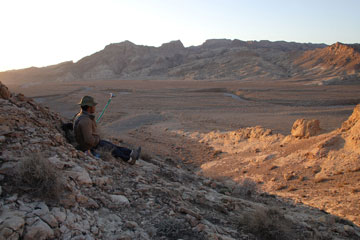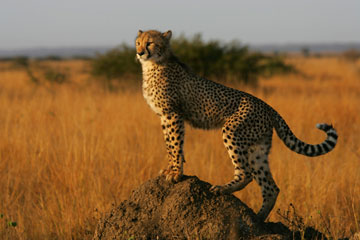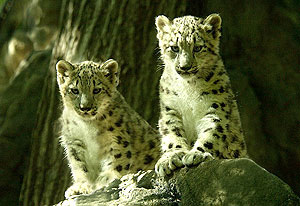How to save the world’s big cats
An interview with biologist Luke Hunter:
How to save the world’s big cats
Big cat conservation requires sound science and practical interventions
May 21, 2007
Big cats are some of Earth’s largest and most threatened predators. Long persecuted as perceived threats to livestock and humans, hunted for their skins and purported medicinal values, and losing critical habitat to deforestation and conversion for agriculture, big cat populations have dwindled around the world for the past century. Recent years have seen the extinction of two sub-species of Indonesian tiger, the Caspian Tiger from western Central Asia, a sub-species of clouded leopard from Taiwan, and the Barbary lion from the wild in North Africa. Meanwhile, populations of the Iberian lynx, Asiatic cheetah and Amur leopard have fallen so low that they would be functionally extinct without current conservation efforts. Tiger populations have declined from more than 100,000 at the turn of the century to less than 6,000 today, while cheetah number are estimated at less than 15,000. Even lion populations have dropped: from over 100,000 one hundred years ago to probably less than 40,000 today.
Given these trends, it should come as no surprise that big cats have become the focus of conservation efforts. Not only are large predators often the most vulnerable to human pressures and the first to disappear from ecosystems, but efforts to conserve them effectively help protect thousands of other species that share their habitat.
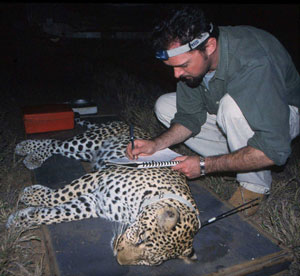
Luke Hunter collects data on an anaesthetized female leopard in South Africa’s Phinda Game Reserve, part of a long-term study assessing the effects of legal and illegal hunting of the species. Photo by Guy Balme. |
At the forefront of these efforts in Dr. Luke Hunter, a biologist with the Wildlife Conservation Society (WCS) where he heads their Great Cats Program. While he has worked in Africa since 1992, in the past year Hunter has tracked highly endangered Asiatic cheetah in Iran and jaguars in the Brazilian Pantanal and is part of an effort to develop a comprehensive plan to conserve the snow leopard throughout its range. Hunter believes that understanding the biological needs of these species — through careful research that sometimes includes tagging and remote monitoring of animals — is the first step in saving them. Alongside that, he strongly advocates collaboration between conservationists and local people to minimize predation of livestock (often overstated) and activities that threaten predator populations.
In a May 2007 interview with mongabay.com, Hunter discussed strategies for conserving carnivores and offered insight for students interested in pursuing careers in conservation science.
Rhett A Butler (Mongabay): How did you become interested in wildlife and specifically big cats?
Dr. Luke Hunter:
I was drawn to animals and wildlife from a young age. My parents say that I latched onto wild cats when I was three years old and the interest never waned. I am still fascinated by big cats but professionally they interest me now because of the conservation issues surrounding them. All big cats have undergone major declines in numbers and loss of range, which in some cases, has left them seriously imperiled. Lions, tigers, jaguars and numerous other cat species are now “conservation-dependent,” meaning that their persistence in large contiguous populations is now directly connected to targeted conservation action. If we simply stopped those activities, we would certainly lose some key populations; in a handful of critical cases such as the Iberian lynx, Asiatic cheetah and Amur leopard, we could lose the entire remaining population.
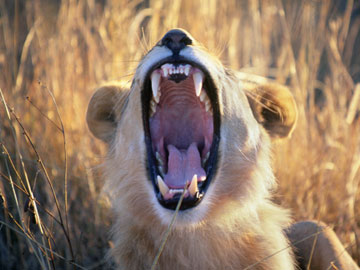
The lion is rarely thought of as a species in conservation need but the species has undergone a decline of around 80% of their historic range in Africa. Lions are persecuted heavily outside protected areas across much of their remaining African range. Photo by Luke Hunter |
Importantly, conserving wild cats is not simply about the preservation of a handful of individuals for their own sake. Like many large carnivores, big cats require large, relatively wild areas with healthy prey populations. So to protect a viable population of big cats, one has to conserve the entire ecosystem on which the cats rely. It means that cats are very effective tools for conserving biodiversity; setting aside an area large enough to secure a population of tigers or snow leopards also secures the thousands or tens of thousands of species that also live there- everything from the snow leopard’s ungulate prey to invertebrates in the soil, to the many plant species that both consume.
2. It seems there aren’t too many big carnivores left in your native Australia. Have you done much work there? Where do the bulk of your studies take place?
Hunter:
I grew up in one of the few countries on earth with no indigenous placental carnivores! We have the dingo which was brought across by people from south-east Asia some 3500-4000 years ago but otherwise, Australia has never had any native species of cats, dogs, bears and so on (native cats’ or more correctly, quolls, are marsupials not closely related to the placental carnivores). I’ve never done any of my own field research in Australia. I left when I was 23 to go to South Africa to begin my MSc on lions and cheetahs, a stint that was supposed to last 2 years. My masters grew to become my doctorate which I followed with a post-doc, so I ended up staying in South Africa for nearly 8 years. I still have a one project in South Africa, a long term study of leopard population dynamics under different levels of threats from people, which is now led by a very talented South African PhD student of mine, Guy Balme.
Mongabay: Even under ideal settings, predators invariably take the occasional cow or goat. Given this, what’s the best way to minimize the impact of predators on livestock? How do you encourage local people to not take up arms against opportunistic predators?

Hunter’s team setting humane soft-catch foot-snares for Iranian cheetahs and Persian leopards on the remote Iranian plateau. Photo by Luke Hunter Iranian MSc student Hadi Fahimi with radio-tracking gear monitoring cheetahs in Iran’s Bafgh Protected Area. Photo by Luke Hunter |
Hunter: I think the key lies in reducing peoples’ problems—real and perceived—with carnivores. I say real and perceived’ because carnivores are rarely responsible for the majority of losses experienced by livestock owners. In fact, where really good data are available, it’s very revealing that carnivores are often quite far down the list of factors that cause losses. Other causes such as disease, starvation or even where livestock simply goes missing are often far more damaging but people—especially poor, rural people—accept these things as acts of God’ or perhaps just the cost of doing business. However, they often feel that they can address the carnivore threat because it’s fairly easy to pick up a gun and go shoot one!
So, we attack the problem from all sides. Demonstrating to people that carnivores may not be their greatest problem is the first step but that might not help much unless you can address the other factors; so for example, helping local people with their veterinary needs for livestock might be a very good way to reduce overall losses so that they don’t feel the losses to carnivores so keenly. As well as that approach, we now have more tools and techniques than ever to mitigate the damage that carnivores do cause. In many, many cases (not all), a simple change in husbandry approaches can have a dramatic effect. Perhaps all a herder needs to do is bring in or guard his cattle when they are calving, so that the opportunities for carnivores to kill vulnerable calves are reduced. Or maybe he can switch from herding dogs (which traditionally chase livestock when a threat appears, in turn provoking a chase from the predator) to large, livestock guarding dogs that have been used for centuries in places like Turkey and Iran, which chase the threat rather than the herd. We try to work with local people to help them adopt techniques like these, often by providing or helping to provide the materials, training and even covering the costs.
Mongabay: Big cats also face threats from poachers. What’s the best way to control illegal hunting?
Hunter:
There are two main ways that illegal hunting impacts cats. The first is the targeted killing of cats, usually for their parts because they are valued in some way. This is especially profound in much of Asia where traditional medicinal beliefs drive a demand for bones and other parts of tigers (and other cats). The second major impact of hunting comes when the prey species of cats are hunted for the pot. You can have perfectly good, essentially intact habitat which is useless for big cats because the prey species have been hunted out by people for their own consumption.
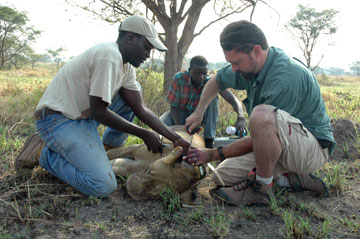
Uganda vet Joel Ziwa, field assistant Mustapha Nsubuga and Hunter fit a radio collar on a lioness in Kigezi Wildlife Reserve, Uganda. Photo by Andrew Plumptre |
Controlling both types of illegal hunting first requires strong enforcement of laws. It isn’t very fashionable these days to promote the idea that local people should be prevented from hunting or consuming wildlife products because doing so may have their origins in traditional practices, but there are some species and some places that should be off-limits. Strong laws and the national and international capacity to enforce them are absolutely essential to ensure the persistence of protected areas and protected species. In the case of hunting for subsistence (not for cats, but for their prey species), providing alternatives might be the answer. If local people are relying on the forest for their protein, introducing some limited farming of small stock like pigs and chickens might help (combined with strong efforts to make sure they are not vulnerable to predation, which would create another problem!). And finally education is important. Millions of people consume wildlife products because of their purported medicinal value, the great majority of which have no scientific or medical basis. Convincing people of that is a huge challenge.
Mongabay: Looking at legal activities, can trophy hunting play a role in conservation?
Hunter:
In principle, trophy hunting can play a significant role. In parts of east and southern Africa where I’m most familiar with hunting, large hunting concessions can contribute to keeping wild areas wild. If not for the revenue generated by hunting, many of those areas could be viewed by governments for activities that would be far more destructive to wildlife and biodiversity, for example, for livestock, agriculture and so on. Non-consumptive’ wildlife tourism is not an option at many of these places because they are undeveloped, too remote, have malaria present and so on. Hunters tend to be more tolerant of these things than the average traveler.
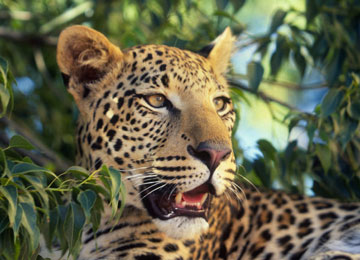
Adaptable and widespread, the leopard is faring better than most large cats. Nevertheless, recent work by WCS scientists in central Africa has shown the species is disappearing from large tracts of otherwise intact rainforest under intense pressure from bushmeat harvests. Photo by Luke Hunter
Cheetahs rarely cause the kind of livestock losses that more ‘damaging’ species like lions create. Unlike lions, cheetahs are able to fare relatively well in livestock-dominated landscapes provided pastoralists maintain healthy wild prey populations and reduce unnecessary killing of the species. Photo by Luke Hunter |
Having said that, I think trophy hunting of big cats is managed very poorly in many places. Quotas are often assigned on the basis of very little information or very poor science. Take leopard hunting as an example. Leopard quotas are still most often justified using a badly flawed model produced in 1988 that related rainfall to productivity; essentially, the model predicted that high rainfall areas could support the greatest biomass (including of leopard prey) and therefore, the most leopards. It was a reasonable idea but its execution was very simplistic and it produced impossible over-estimates of leopard numbers. Despite being widely and continually criticized by carnivore biologists and wildlife managers, it is still used by governments today to establish harvest levels.
Lion hunting is also problematic. There are now very good data available showing that the impacts of shooting male lions has ripple effects throughout the larger population, a result chiefly of accelerating the natural turnover rate of pride males and therefore, of infanticide—the killing of unrelated cubs when new males take over a pride. Both Craig Packer’s team working with his long-term dataset from the Serengeti, and David Macdonald and Andy Loveridge working in Zimbabwe’s Hwange National Park have produced very strong arguments for either reducing hunting quotas or limiting the age of males which can legally be shot.
I am not opposed to trophy hunting but I feel strongly that it must be based on good science and it must be sustainable. With few exceptions, that rarely happens in the case of hunting large cats.
Mongabay: Why is it important to trap and tag wild animals for conservation work?
Hunter:
Doing effective conservation relies on very strong science, and in many cases, the only way to collect the necessary data is to catch animals and fit them with radio-transmitters. Let me give you an example. My team and I recently succeeded in capturing Asiatic cheetahs in Iran for radio-collaring. There are only about 60-100 Asiatic cheetahs remaining in the world, all of them in Iran, and we know very little about them. The collars will help us answer some key questions about their behavior and ecology; the size of areas that Iranian cheetahs require for their home ranges, the routes they take to travel between existing protected areas, the key features in the landscape on which they depend- for example, as den sites for females- and so on.
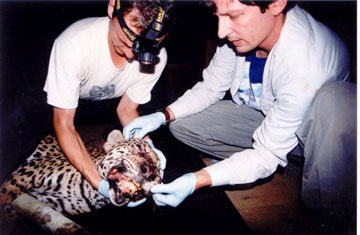
. |
These questions are more than merely academic, because without the answers, we cannot plan a meaningful conservation strategy that gives the cheetahs the greatest chance of survival. In the absence of such information, the resulting activities or actions are often those which have the least resistance towards them; for example, the places that become parks are those areas which are politically least problematic to protect—the areas that no-one else wants or uses. But, if as I suspect, the conservation of the cheetah in Iran hinges on protecting certain landscapes that are also sought after by people, for example, to graze livestock, to convert to agriculture, to put in the next highway and so on, we need to be able to demonstrate with strong science how that will impact the cheetahs. The collars will help to provide those answers.
Equally, it is just as important to ask the question, does conservation of the species require radio-tagging? There are many, many cases where it does not. I often read proposals by graduate students who are wishing to radio-collar cats to address a conservation issue when they could far better achieve their goal by some other means. If the main threat to a lion population living in an African game reserve is being killed by local pastoralists outside the reserve, I’d argue you don’t need to collar a bunch of lions to address the problem. The most immediate priority is more likely to involve working with that community to find out why they kill lions and if there are ways to reduce it. Assuming you already know enough about lions and the reasons for the conflict, radio-collars won’t help.
Mongabay: How to you reduce the risk of injury to wild animals when they are trapped or darted? Is a woozy animal more vulnerable to predation itself when recovering from capture?

Testing new technologies. Camera-traps- remotely triggered cameras- are an extremely useful tool for establishing population estimates of shy, cryptic cats. Here, snow leopards in New York’s Bronx Zoo put some new models through their paces. Photo by Julie Maher
Two snow leopard cubs at the Bronx Zoo. Photo by Julie Larsen Maher. |
Hunter:
Trapping or darting animals does increase their vulnerability, so it is critical to reduce that as much as possible. The great bulk of biologists I’ve met are very concerned about this and take great care in reducing the risk. So for example, we use recovery cages’ for animals coming out of sedation—that is, placing the animal inside a wooden box crate to protect it from danger, and only releasing when it has fully recovered. Also, depending on the species, there are now some anesthetics with effective antagonists that reverse the anesthesia. This is common with ungulates but not with carnivores- newer drugs are proving hopeful for many species. Even without these antagonists, the most important thing we do is remaining with the animal until it is fully recovered. Typically, we move off a short distance to watch the recovery with binoculars without the animal getting agitated by our presence but remaining close enough to intervene if a threat appears.
Having said all this, it is important to note that capture-related accidents of the kind you describe are rare. It can take weeks of effort just to catch one carnivore; the chances that another turns up while your critter is recovering is fairly low.
Mongabay: Do you have any notable close-calls working with big cats?
Hunter:
Not really. I was once bitten’ on the thigh by a lion as he woke up from sedation but he was still very groggy. If you’ve ever had anaesthesia, you can probably imagine what that was like—it was like being mauled by a sponge. He left a few bruises.
Mongabay: Do you have any advice for students who are interested in pursing wildlife conservation fieldwork?
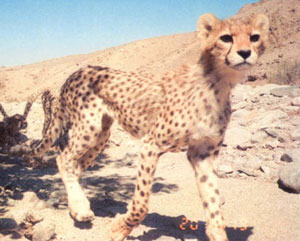
Female Asiatic cheetah captured with a remote camera in Iran. Photo courtesy I.R.Iran DOE/CACP/WCS/ UNDP-GEF |
Hunter:
Apart from taking all the appropriate classes in school and university, I think one of the best things students can do is volunteer their time on conservation or research projects. The biology departments at local universities are often excellent places for making contacts with graduate students who need help with their field work. Check out their notice-boards or even better, post your own notice offering to help with field projects. Grad students probably won’t be able to pay anything but they usually cover costs (food etc) and more importantly, it is a fantastic way to gain field experience. And at the same time, it tests you. Field work is often boring, frustrating, dirty, physically demanding etc etc, not at all the glamorous occupation that people often think—so it allows you to decide if it’s really for you. And if it is, then having the experience counts for a lot in eventually securing your own place in a graduate program; potential advisors take note of students who have already gone to the trouble of gaining field experience off their own bat. There are also some good online resources for opportunities like this; one of the best is the Society for Conservation Biology’s job pages.
For students who already know they want to work with cats, there are now some incredible opportunities to make it happen. One of the most exciting that Im involved with is a new grants program created by the Panthera Foundation which supports graduate students working on cats. The program is only 2 years old but has already made grants to 27 post-graduate students, working on 15 cat species, in 18 countries. See Panthera’s webpage for information.
Mongabay: How can people at home help protect big cats and other endangered carnivores?

Jaguar on the Rio Cuiaba in the Brazailian Pantanal. The Pantanal is one of the most important areas globally for jaguars and is 95% privately owned, mostly by cattle ranchers. Photo by Luke Hunter. |
Hunter:
Of course one of the most important needs is for funding; there are many good conservation organizations working to save carnivores and all of them rely on donations. A great deal of conservation could never happen without that support—make a donation if you can. Visiting wild areas also helps; whether it’s a once in a lifetime trip to the Serengeti or a stay in Florida’s Everglades National Park, tourism helps to subsidize the perpetuation and protection of many wild areas. Finally, getting involved politically is tremendously important. Protecting wild areas and wildlife is often politically unpopular because it goes against the interests of powerful, wealthy interest groups, so making a stand is where every individual’s voice really counts. Right now, on WCS’s webpage, you can sign onto a petition asking Congress to pass an appropriation bill to fund the conservation of endangered carnivores.
Learn more
- Great Cats Program at WCS
- Urge Congress to support the Great Cats and Rare Canids Act
- Wildlife Conservation Society
- Panthera Foundation


